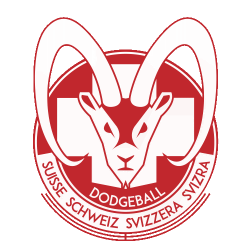Official court diagram
Rule 1 - The Playing Area
Section 1. Dimensions
- The playing area is the area which contains the court, free space, player out box, penalty box and substitution area. It should be enclosed by barriers or netting on all four sides to prevent balls from exiting.
- The official court size is a rectangular area of 18 meters in length and 9 meters in width.
- If the available space does not allow the official measurement, a court of minimum 16m in length and 8m in width is allowed.
- All lines should be marked out as 5cm wide. They must be uniform, and different in colour to the floor or other lines.
- The court boundary is marked by two side lines and two back lines. They are drawn outside of the dimensions of the court, as they are not part of it.
- The centre line must be marked exactly halfway between each back line. The line should extend at least 1 meter outside of the side lines, to guide the ball retrievers.
- Markings on the center line should be placed to aid with ball placement. There are 5 markings, starting from the centre point of the court towards each side line marked 1.5 meters apart.
- The activation lines are marked 5.5 meters from the centre line, parallel to it and enclosed by the side lines.
- The neutral zone lines are marked 7 meters from each back line, parallel to it and enclosed by the side lines.
- The court is surrounded by a free area of at least 1 meter on all sides.
- Ceilings and any other overhead obstacle should be at least 4 meters above the court surface..
- The playing surface must be flat, horizontal and not slippery, not presenting any safety danger, according to the officials check before a match; should the hazard appear later, officials can suspend play to remove it.
Section 2. Zones
- The fair territory is the area from the back line to, but not including, the neutral zone line on each side of the court and enclosed by the side lines.
- The neutral zone is the area between, but not including, the two neutral zone lines and enclosed by the side lines.
- The player out box (or 'Queue) is an area of at least 1 meter in width, located 1 meter away from the sideline of the court, extending from the back line for 5 meters. The player out box must be marked with lines and should be placed diagonally opposite to the head referee where sufficient space is available.
- The substitutes area is an area of at least 1 meter in width, located behind the player outbox. In unofficial EDF or FSD events, if the available space doesn't allow for a substitutes area it may be omitted provided adequate provision for easy access to the court area has been provided for substitutes to enter from either end of the court boundaries.
- The penalty box is an area extending from the player out Queue, towards the direction of center line by 1.5 meters and should be the same width as the player out queue & substitutes area combined.
Rule 2 - Equipment
Section 1. Dodgeballs
- EDF or FSD adult events must use 'Size 3' dodgeball, measuring 7 inches/17,78 centimetres in diameter.
- The dodgeball's internal pressure should measure between 1.6 to 1.8 psi / 110 to 125 mbar
- Dodgeballs must use balls made of a butyl bladder, covered by webbing and a textured no-sting cloth covering which has a 2-4 mm layer of foam directly underneath it.
- Balls must be in spherical shape and be uniform in terms of circumference, weight and pressure.
- Match officials can deem any dodgeball that does not fit these standards as unfit for play.
- The design of dodgeballs used in EDF or FSD events must be evaluated prior to the event by EDF or FSD, who will approve it considering both the acceptability of sponsors and logos, as well as the prints size.
Section 2. Uniforms
- All players on a team must wear uniforms identical in colour and design.
- Length of the sleeves may differ from player to player.
- Shorts, pants, leggings or other kinds of clothing can be worn on the lower part of the body, even differing from player to player, as long as the colour is consistent in the team.
- All kinds of visible sports base layer garments can be worn underneath the uniform.
- Each player needs to be identified by a visible number (0-99) on the back of the top. A player must maintain the same unique number throughout a competition (in mixed and gendered, this can differ).
- A player will not be penalised for a uniform mismatch if their uniform needs to be changed due to bleeding or to damages occurring to the uniform during play.
- Ball retrievers must not wear a uniform similar to the one used in play by their team.
- Team leaders (eg: coaches and managers, as defined below in Rule 3 - Participants) and referees should be easily identified and not mistaken with regular players. Captains must be identifiable.
- Sponsors and logos displayed on uniforms at EDF or FSD events need to adhere to EDF or FSD guidelines. Illegal, offensive or discriminatory images and text will not be allowed.
Section 3. Other equipment
- No equipment is allowed if deemed dangerous or harmful to the safety of the wearer or other players.
- No equipment is allowed if deemed significantly enhancing player performances beyond normal limits.
- All protective equipment must be worn correctly and be in working condition.
- Any other equipment not specifically outlined in the rules may only be used after approval by the match officials.
- Headbands and protective helmets are the only permitted headgear for players.
- Prostheses may be worn. All casts, braces, and splints with exposed hard surfaces must be padded.
- Gloves must not be worn, except when medically necessary, as required to be proven by the player. Any medically necessary glove must not enhance the ability of a player in the game.
- Exposed jewellery, potentially dangerous for the wearer or others, must not be worn during the game. Match officials can order for this to be removed if they notice it. If not following this rule causes a player to hurt themselves or others, the wearer will be held fully responsible.
- Goggles or sporting glasses may be worn and must be secured with head straps.
- Shoes must be worn at all times, and must be made of canvas, leather, or similar material with a rubber non-marking sole. Shoes deemed unsafe by match officials must not be worn.
- Substances applied to the exterior of team uniform or onto the skin of a player which enhance the ability to throw or to catch are not allowed.
- Substances applied to players skin for medical reasons or to aid an injury are allowed, but need to be covered by a dressing if necessary.
Rule 3 - Participants
Section 1. Players
- Teams consist of 6 players with up to 6 substitutes, unless an unofficial EDF or FSD competition has other requirements.
- All players must be in uniform with their name and numbers listed on the line up sheet. Players cannot be added after the match has begun.
- A team can consist of no more than 12 players per match. A player may only participate in a tournament they have registered for.
- In an EDF or FSD event, a team can register a maximum of 14 players, but only up to 12 per single match are allowed to be part of the game.
- Mixed teams must field a team consisting of both genders but no more than 3 players of a single gender may be on court at any time
Section 2. Team leaders
- A team may have no more than two designated leaders (coaches, assistant coaches, or managers) within the playing area during a match. This does not include media staff, as regulated separately by EDF or FSD guidelines.
- A player may be designated as a coach.
- Team leaders are responsible for the team's actions on the court and, alongside the captains, will represent the team in communication with the match officials and opposing team.
- Team leaders must address only their team members and the officials.
- Team leaders must always use polite and respectful language and manners
- Team leaders must remain confined to the combined areas of the Player Out Queue, Penalty Box and Substitutes Area for their team. They must not enter the court without authorization from an official.
- Team leaders are subject to all rules of conduct.
Section 3. Line-up cards
- If prescribed by the competition rules, a line-up card must be completed and submitted to the competition coordinator or to a head referee before their team's first set of a match.
- Line-up cards must contain names and uniform numbers to identify all participants: players, team leaders, retrievers.
- Once the line-up card is checked and approved, it becomes official and cannot be changed; people not listed in the lineup card are ineligible and thus not allowed in the playing area. Ineligible players will be removed from the playing area without the chance for their team to replace them.
Section 4. Substitutions
- Substitutions must be made prior to the start of a set. No substitutions can be made during a set, except in cases of injury.
Section 5. Short handed rule
- Should a player get injured, they'll be replaced on court by the first player in the Out Box, and this last player will be replaced by a substitute who takes place at the end of the Queue; should there not be any players in the Out Box, a substitute can immediately enter the match.
Section 6. Retrievers
- A retriever is an individual designated to retrieve balls outside of the court.
- Each team can have up to 3 retrievers, but must have a minimum of 2. Tournament officials will specify if there are further requirements.
- Retrievers can be changed between sets, as long as they are all listed in the line-up card.
- A retriever may not enter the court at any time.
- A retriever is only allowed to field balls that are outside of the court's boundaries and have not passed the court's central line towards the opposing team.
- Retrievers must collect balls as soon as possible, but they are not required to put them back in play immediately. If a ball is kept out of play by a retriever, they must ensure the ball is clearly visible to officials, eg: by holding the ball aloft above their heads.
- All balls in the possession of a retriever (regardless if they are putting them back in play or holding them) are considered in their team's possession and therefore must be included in the 'Play ball' count.
- When returning a ball to play, a retriever may either throw a ball to any active player behind the team's activation line or place the ball on court behind the team's activation line.
- The requirement of being behind the activation line does not apply to the retriever, but to the player receiving the ball; if by mistake the ball is collected in front of the activation line, the ball needs to be carried back behind the activation line, otherwise it cannot be used either as defence or to hit opponents out, although it can produce negative effects such as being caught if thrown.
- A retriever may not: touch, move or interfere with a ball that is within the court boundaries either through direct contact with the ball or by deliberate use of a ball they have retrieved; cause a ball to be transferred to the opposite team through any means; make contact with an opposition retriever or player; touch a teammate so that they get an unfair advantage, not justified by the transfer of a ball (for example, stopping them from falling outside of the court).
- If a retriever commits an infraction the match officials may apply the following actions in order of severity and occurrence:
- Warning: for involuntary mistakes which do not impact the game, and/or mistakes which can be easily fixed (examples include: touching a line, touching part of the opponents' territory, passing a ball in front of the activation line)
- Turnover: for errors which impact the balls distribution (examples include: touching a ball inside the court or in the opponents* territory, transferring balls to the opponents). When the official yells 'Turnover' during play, possibly without the need to interrupt the game, the faulting team must immediately transfer all five balls to the opponents. If the opponents receiving the balls wish to have less than all five balls, they must immediately roll back any balls they do not want (or rapidly communicate how many balls they want, if they have not received them yet)
- Yellow card, for unsportsmanlike or reiterated infractions
- Red card, for severe violations leading to this penalty
Section 7. Other ways of retrieving balls
- A player can pick up any ball they are able to reach, regardless of where that ball is located (therefore also outside of the court, or in the opponents' territory beyond the neutral zone).
- It is not allowed to physically grab a ball from an opponent if it's already in their possession.
- People in the zones outside of the court (coaches, assistants, managers, out players, substitutes) can pass to player on court any ball which is outside of the court, so long as they do not leave their designated area to retrieve them. When doing this, they must ensure the ball returns to play behind the activation line, as regulated for retrievers.
- Spectators may return a ball to play that has gone out of bounds, making sure it comes back to the team it belonged to; this can be done also by giving it to an official or retriever.
Section 8. Discipline
- All participants are subject to the authority of the match officials at all times. Any situations that arise between the team representatives 5 minutes before or after a match containing those representatives will be considered as part of that match and appropriate actions will be applied as though they occurred during the match.
Rule 4 - The Match
Section 1. Style of play
- The EDF or FSD-approved style of play regulated in this document is the 'Cloth' format
Section 2. Court Choice
- If teams disagree on the choice of a court side, this must be determined by a coin toss.
- Teams switch sides after the half-time break.
Section 3. Match duration
- A regulation match will consist of two 20 minute halves, with a 5 minute half-time break.
- The 20 minutes are continuous, to be paused only as regulated in the following sections.
- A match consists of an indeterminate number of sets.
- A set starts at the whistle of the officials and lasts until one team is eliminated, or until the time for the set expires.
- The maximum duration for a set is 3 minutes of effective play.
- After a set ends, officials will wait 30 seconds for teams to reset.
Section 4. Clocks
- The match clock will start with the start of the first set of each half.
- The match clock is only to be paused:
- during a timeout;
- when play is suspended by the referee;
- when a 'final set is going to be played.
- The set clock will start with the start of each set.
- The set clock is only to be paused when play is suspended by the referee.
- Penalty clocks start when a player receives a yellow card.
- Penalty clocks are run continuously and are only paused in conjunction with the match clock, for example during time outs.
Section 5. Final Set
- If less than 120 seconds remain of a match half after a set ends, a final set must be played.
- The set timer for the final set is 90 seconds. This is the maximum length this set may run for.
- In the event of any false start in the final set, the 90 seconds will restart.
- If the final set is won by elimination before the 90 seconds expire, the half ends.
Section 6. Tie-Breaking Set
- In knockout tournament play, or whenever a set cannot end with a draw, a tie-breaking set is played at the end of a match when the score is tied.
- The duration of a tie-breaking set is 3 minutes.
- If a winner cannot be determined before or at the end of the tie-breaking set, the match officials will call "sudden death" and the first team to eliminate an opposing player wins the set and therefore the match.
Section 7. Time outs and suspension of play
- Each team is allowed one timeout per half. If they do not use a timeout in the first half, they are still only allowed one timeout in the second half.
- Each timeout lasts 60 seconds.
- Timeouts can only be called between sets, before the officials call "Line up".
- Referees can suspend play at any time during the match if they consider it necessary.
- During a timeout or a suspension of play called by an official, all match and penalty clocks will be paused, and resumed when the game starts again.
- During a suspension of play, all participants must remain in their designated areas.
- If an official signals that the match is suspended during play, players who are still on court will resume the game starting with one foot on the back line.
- As the game restarts, teams are allowed to take all balls within their court side to the back line with them during the lineup. Any balls in the neutral zone belong to the team whose side they are closest to.
Section 8. Scoring
- A set is won by the team who eliminates all the opponents before the set ends.
- If the set ends before one of the two teams has eliminated all the opponents, the team with the most players still on court wins the set. If both teams have an equal number of players on court, the set ends with a draw (unless it is a tie-breaking set).
- Each set awards 2 points: the winner gets 2 points and the loser gets 0 points; in case of a draw, both teams get 1 point.
- At the end of a match, the team with the most points wins the match.
- If the score is tied, the match is drawn; if the competition requires a winner, such as during knockout rounds, a tie-breaking set is played.
Section 9. Forfeits
- A set is forfeited by the team which is not on court to begin the first set in a match at the scheduled time. Match officials will then allow the team who has forfeited the first set a maximum of 3 minutes to be ready for the second set, otherwise they will forfeit the match.
- A set is forfeited when, due to penalties, a team does not have enough players to start a set: the team will forfeit a set every 30 seconds until they are able to field one player and start a set again.
- A set is forfeited when a team receives a team yellow card.
- A forfeited set awards 2 points to the opposing team.
- A team may forfeit a match for serious infractions leading to a team red card, as for example extreme unsporting conduct, aggression or violence; refusal to leave the court by expelled individuals; refusal to restart the game.
Rule 5 - Starting The Game
Section 1. The Rush
- Play begins with all players positioned on or behind their team's back line. Players may lean over or beyond the back line, but may not touch the court with any part of their body.
- The head referee or other designated starter will follow with these instructions to start every set:
- "Line up" to order teams to take their places;
- "Teams ready" for the teams to get into position to rush;
- The official will pause for approximately 1 second and then blow a whistle to signal the start of the set.
- After the whistle, both teams rush to centre court and attempt to retrieve the two balls to their left designated for their team only, and the one ball in the centre (which is available to either team).
- A maximum of 3 players per team are allowed to rush. Any additional players who cross the activation line before the balls have been made live will be called out.
- After the whistle has been blown to signal the start of a set or a reset, all players become live players.
- All players must be fully within the boundary lines before the first player touches a ball on the centre line, otherwise they will be called out.
- When retrieving their 2 designated balls, players may step onto or over the centre line with one foot.
- Players rushing for the central ball are not allowed to touch the centre line or the court beyond the centre line with any part of their body, including their uniform.
- A player may not slide or dive head first when rushing for the central ball.
- No deliberate physical contact between players is allowed, when rushing for the central ball. The offending players will be called out. Incidental contact will not be penalised. Pulling the central ball while the opponent is also holding on to it will not be penalised if there is no physical contact.
Section 2. Ball activation (during Opening Rush)
- Any ball retrieved during the opening rush must be activated by the team who retrieved it, in order to become a live ball.
- This happens either when:
- the ball fully crosses the activation line, whether this happens by being carried by a player or by being passed by a player or a retriever;
- or, the ball is passed to a player who has both feet in contact with the court behind the activation line.
- After the rush, a ball that has yet to become live is a dead ball: if thrown, its hits are voided, but catches by the opponents are valid. A dead ball can be used for defence to block throws.
- After the rush, players are only permitted to cross the centre line when:
- they are carrying a live ball;
- or, a live ball has been thrown or carried over the centre line;
- or, all their designated balls have been activated.
- As a team can only retrieve the two designated balls on their left and the central ball, only those balls need to be activated: if a designated ball ends up in the opponents' court, it is already activated without the need to go behind the activation line.
- Once all their designated balls have been activated, a team may retrieve any ball on the centre line.
Section 3. False starts
- Players must remain stationary and not move forward after the match officials call "Teams ready" and until they blow the whistle. If a player breaks this rule, it will be considered a false start.
- A false start is called only when the player who moved before the whistle carries on with their rush and crosses the activation line; if said player stops their movement before crossing the activation line, this does not constitute a false start.
- After the match officials stop the game to call a false start, the non-offending team will receive all 5 balls, and the teams are then reset.
- At the reset, all the balls are already live.
- If both teams false start, the team which, according to the officials, was the first to move will be considered the offending team; if the officials are unable to determine which team initiated the false start, there will simply be a reset.
Rule 6 - Offensive & Defensive Play
Section 1. Outs
- A live player shall be deemed out when hit by a live ball on any part of the body (hair included, or any part of their uniform or clothing.
- A live player shall be deemed out when a ball they have thrown is caught in flight by an opponent.
- A live ball remains live even after it rebounds off another live player, an exiting player, another ball (regardless if said ball is flying, blocked, held in control or lying on court). Said live ball is therefore still able to hit out or be caught by multiple players, from either team, until it becomes a dead ball.
- A live player shall be deemed out when the player touches or crosses one of the boundary lines (side lines, back lines, end of the neutral zone line)
- A live player shall be deemed out when they fail to throw a valid attempt.
- A live player shall be deemed out when their team fails to throw the required number of balls when "Play ball" is called, according to the specific rule.
- A live player shall be deemed out when they get disarmed by a throw.
- A live player shall be deemed out whenever an official ascertains they committed a rules violation.
- A player hit is out at the moment of contact. Although the ball remains a live ball the player may no longer make any plays other than to catch the ball that put them out.
- Fair play rule: if the player believes themselves to be out and leaves the court, the referee can decide to bring them back if they believe them to not be out (for example the player failed to notice the ball bounced prior to hitting them). In this situation, if the player has left the court, they must return through the back of court.
Section 2. Throwing
- Balls may only be thrown, with the exception of the block attack. A throw may be performed with one or both hands and be overarm, underarm, side arm or chest push/throw.
- A throw must leave a player's hand. An opponent may not be "tagged" out.
- Once the ball is no longer in contact with the player, the ball becomes a live ball, and remains so until it touches a surface or dead object.
- Only active balls can lead to a valid throw: if any inactive ball is thrown, it cannot hit an opponent out, but can be caught by the opponents.
- Intentionally kicking a ball or spiking a ball in an unsporting way will result in an out for the offending player.
- A player may not throw or kick the ball once play has stopped or after being called out. Actions deemed as flagrant or unnecessary will result in a yellow card.
- If a ball is thrown and it hits the head of a player above the shoulders, the headshot is normally valid and no penalties for a headshot shall be enforced. However, penalties will be considered if the throw is deemed unsporting due to close distance and excessive aggressivity, in situations where referees consider other body parts could have been targeted instead.
- A ball must never be held in a way that would damage it, nor must be distorted in a way that would alter its normal flight pattern when thrown ("pinching*); pinching a ball will result in an out, and if persistent can result in a yellow card.
Section 3. Invalid attempts
- A throw must be deemed by officials to be a valid attempt to hit an opponent out; as such, only throws landing or passing within 1 metre of where a player is or was when the ball was released will be deemed valid attempts.
- If a player fails to make a valid throw, they are deemed out.
- Transferring balls to the opponents in any way, regardless if intentionally or not, other than a valid throw or block will be considered an invalid attempt, in the moment the ball crosses into the opponents' fair territory or past the centre line when out of bounds.
- Examples of invalid attempts include (but are not limited to) rolling the ball, passing plays, dropping a ball they had control of, which rolls over the aforementioned lines.
- If a player drops a ball to make a catch, and the catch is successful, the player will not be called out even if the dropped ball rolls over into the opponents' fair territory or past the centre line when out of bounds.
- Carrying a ball into the neutral zone and leaving there, unless unintentional, constitutes an invalid attempt.
Section 4. Catches
- A live ball can be caught in flight by an opposing player. A catch is considered valid at the moment when the ball is considered in control of the catcher, at the discretion of the match official.
- At least one of the catcher's hands must be in contact with the ball for it to be considered to be in control.
- The catcher is not required to have any points of contact with the court for a catch to be considered valid. If the player catches a ball mid-air, and the match official deems they already had control of the ball, the catch is valid. Any subsequent actions (for example landing out of bounds or being hit) will be considered separate, and if the catching player will be deemed out later, this does not compromise the validity of the previous catch.
- After a catch, the opposing player who threw the ball, or from whose ball or body the ball rebounded off, will be immediately deemed out. The first out teammate of the catching player in the queue becomes a returning player and must return to court immediately.
- Illegally thrown balls, while not being able to hit out opponents, can always be caught.
- If the catch happens mid-air and the catching player lands into the opponents' court, they will be called out for being out of bounds, but would also be punished with a yellow card if the jump is considered dangerous.
- If a ball is caught after rebounding off one or more players, the catch is valid but the previously hit players are still deemed out.
- When the caught ball comes into contact with a dead object before the catch is completed ("trapping*), the catch is not considered valid and the player attempting the catch is deemed out.
- If more than one player makes contact with a ball simultaneously, all are considered out.
- Players are not allowed to use any part of their uniform to catch a ball.
Section 5. Blocking
- A player can use balls to block a live ball from hitting them
- The blocked ball remains a live ball and if it deflects off the blocking ball onto the blocking player or any other player, all players hit will be out. If they catch that ball, the catch is valid.
- After the rush, when a ball is being carried back to be activated for the first time, it can be used for defence; after this moment, during normal play a ball that is not active cannot be used for defence, and if a block happens, the player holding the ball will be considered hit.
- When a player uses a ball to block, their hands (inclusive up to the wrist) which are in contact with the ball are considered to be part of the ball; this means that any hit on the hands while in contact with a blocking ball constitute a normal block, and therefore will not cause the player to be called out.
- When a player uses a ball to block a live ball, and as a result of the action they lose control of the ball they were holding ("disarming*"), they must regain control of the ball before it makes contact with any object, player or surface, otherwise they will be deemed out. Shall they regain control of the ball, that is not considered a catch.
- Disarming is the only way for a player to dispossess opponents of a live ball. Physically removing a live ball from the control of an opponent would result in a yellow card.
Section 6. No stalling rule
- When a team has possession of at least three balls, they have 5 seconds to make an attempt with the balls in their possession. If the match official considers that the team has no intention to throw, they will call "play n balls"
- In the case of "play n balls", "n" is calculated according to the number of balls the team has in possession minus one. The team who received the "play n balls" call is then obligated to throw at least this amount of balls.
- After "play n balls" is called, the team has another 5 seconds to throw at least "n" balls; more balls may be thrown if the team wishes to do so.
- A ball is considered to be in possession when a player or retriever has the ball in hand or within a reachable distance.
- If players fail to make an attempt on the opposing team within 5 seconds, the amount of balls left will be the amount of players called out. The players who are holding a ball or are nearest to a ball not being held by a live player are called out. Exception: If a player has already made a valid throw but is still holding a second ball, they will not be called out. If there are other players not holding a ball, the closest player to the one who has already thrown will be called out instead.
- In situations where there are more dodgeballs on their side of the court than there are players, all players must make attempts within 5 seconds, until the opposing team has the majority of the balls For example: a team has 2 players left on court and they have all 5 balls in their possession, the players must both throw balls. Following this play, the players still possess 3 balls and therefore still retain the majority. If they do not throw within the next 5 seconds, stalling rules will call for them to both throw balls, at which point they would have only 1 ball left and majority would have passed to the other side. If, at the point of having 3 balls left, they choose to act before stalling rules apply (throwing within 5 seconds), they could choose to throw only 1 of the balls and still lose the majority, but retain 2 balls.
- In situations where each team has an equal amount of balls, the officials will determine which team can be in possession of the majority of reachable balls based on the nearest player to any dead ball within reachable distance on court.
- If each team has 2 balls and a ball is stationary in the neutral zone, whichever team has the nearest player to the stationary ball will be deemed to have the majority of balls.
- A ball within a team's fair territory is considered to be in that team's possession.
- Any balls in possession of a player hit after a play ball call must be excluded from the expected amount of balls required to be thrown i.e., if a team are called to play 3 balls and a player in possession of a ball is hit out the match officials will only expect the team to throw 2 balls.
Rule 7 - Non-active plavers
Section 1. Exiting players
- An exiting player is a player who has been deemed out.
- An exiting player must immediately drop all balls in their possession before moving from the spot on court they were in when they got called out. An official can assign a blue card if they deem the exiting player has passed a ball to another player or to the opponents.
- Exiting players, in their process of leaving the court, must raise a hand in the air to indicate they are no longer in play.
- An exiting player must exit the court as quickly as possible over the nearest boundary line.
- Once out of the court, an exiting player must take their place in the queue, behind other teammates who have been eliminated earlier in the set.
- Catching the deflection of the ball that hit them, in order to save themselves, is the only action allowed for a hit player before being deemed out.Therefore they will not become an exiting player as long as they are still trying and able to catch the ball that hit them.
- Between being hit and catching the ball that hit them, player might be involved in different plays: if they are hit by another ball, they are immediately deemed out; if they catch a second ball before catching the first one, the catch is void; if they throw another ball, that second ball cannot eliminate opposition players but if it gets caught, the catch is valid. Additional penalties for throwing after being hit will be enforced.
- An exiting player must not intentionally impact play. Should an official determine that they have done so they will receive a yellow card. Examples of impact include interfering with balls, shielding players or throwing balls (note: if the officials considers the timings of hit and throw to be in such close range that the exiting player could not have reasonably been expected to halt the throw, this will not be punished).
- A ball that has hit an exiting player which hasn't been intentionally deflected by that player is still a live ball and can be caught or hit other players out.
Section 2. Out players
- An out player is a player who has been deemed out and is waiting in the queue to return to play.
- Out players in the queue can retrieve balls from the outside of the court, as long as they do not leave their designated area and they activate it following the rules applied to retrievers.
- Out players must not throw balls or interfere with the path of a live ball. Any violation determined to be intentional player interference will result in a yellow card for the offending player.
- After a catch, players from the queue return to play in the order they were put out. A player who enters out of turn receives a penalty set, and must immediately exit the court to the penalty box and their team loses the chance to put an out player back into play.
Section 3. Returning players
- An out player becomes a returning player once their teammates have successfully made a catch, allowing the first out player to return on court.
- A returning player must immediately return to the court; intentional delays will cause the team to lose the chance of putting a player back into play.
- A returning player must enter the court from the back line.
- A returning player is considered in bounds as soon as they have both feet in contact with the fair territory, therefore becoming a live player. Only after becoming a live player, the returning player can be called out or make a catch. Any play happening before that is void.
- A returning player must not pick up any balls while returning on court.
- An out player must return on court from the queue, therefore if a catch happens while the first out player of that team still has not reached the queue, they cannot come back on court directly without first stepping in the queue.
Rule 8 - Boundaries
Section 1. Out of bounds
- A player is out of bounds when any part of their body, or their uniform, or a ball which is already in their possession touches:
- a boundary line (back line, side line, opposition's neutral zone line);
- the opponents' fair territory;
- any surface or object outside of the boundary lines (except for a live ball or a ball they are retrieving);
- any person out of bounds, when it gives them unfair advantage (example: preventing from falling outside).
- Any player deemed out of bounds is called out.
- When a player is out of bounds, they cannot intentionally throw a ball at opponents. The ball thrown cannot result in a hit, but it can be caught by the opponents. Flagrant or repeated violations can lead to a yellow card.
- If a player steps out of bounds while making a play, it is up to the match officials' discretion to determine if the play had been already completed before stepping out of bounds.
Section 2. Neutral Zone
- Players of both teams can play within the neutral zone. Players may reach across the neutral zone into the opposing team's fair territory to retrieve a ball.
- No physical contact can happen between opposing players, or the player who initiated contact will receive a yellow card.
Section 3. Sacrifice play
- An airborne attack, where an attacking player may legally cross the neutral zone to make an attempt to hit out an opponent, is called sacrifice play.
- The ball must be released before any part of the sacrificing player touches the opposition's fair territory.
- If a sacrificing player fails to hit out a player the sacrificing player is deemed out and must leave the court immediately.
- A sacrificing player is successful if the throw causes a player to go out by being hit.
- If a sacrificing player hits out an opponent the sacrificing player remains in but must return to their side of the court immediately. Any intentional delay shall result in a player yellow card.
- The sacrificing player must not pick up any ball from the oppositions fair territory until they have returned fully to the neutral zone.
- Once a sacrificing player, who has successfully hit an opponent, lands within their opponent's territory, they cannot make any thrown attacks until they return completely into the neutral zone. Thrown balls after landing can not put opponents out, but can be caught.
- A sacrificing player, having successfully hit an opponent, can however be hit while in their opponent's territory. This means a player making a successful sacrifice play can still be hit out but they cannot put any defending player out with a thrown attack until they have returned to the neutral zone.
- If the sacrificing player catches a ball mid-air before landing, the catch is valid regardless of if the sacrificial play is successful.
- If, following a successful sacrificial play and having landed in the opposition's court, the sacrificing player makes a catch while within the opposition's territory - before they have returned to the neutral zone - the catch does not put the thrower out, but equally is not a hit. In brief, the catch is null, counting neither as a catch nor a hit. The catching player however can continue to hold the ball as they run back to the neutral zone. The sacrificing player must remain within the court boundaries and return to the neutral zone immediately with or without possession of the caught ball.
Rule 9 - Simultaneous Play
- Simultaneous play occurs when two or more plays happen at the same time and match officials cannot determine which play was completed first.
- In case of simultaneous plays, all results of the play are successfully resolved simultaneously.
- The only exception is when two or more players simultaneously catch the same ball, resulting in all those players to be deemed out.
- Should a simultaneous play result in all players being called out, the set will be drawn.
Rule 10 - injuries
- If a player becomes injured and requires immediate attention, the officials will suspend play to allow medical treatment.
- If the injured player is unable to continue play, they are replaced by the first player in the queue.
- To restore the correct number of players, a substitute is then allowed to enter the game, placing themselves at the end of the queue. If there were no players in the queue (including the injured player), the substitute is allowed to enter the court directly.
- In mixed competitions, the substitute must be of the same gender of the injured player and in queue order.
- If medical care or treatment is administered in a reasonably short length of time, in the officials judgement, and the player is not at risk to themselves or others, the individual may remain in the set.
- Anyone leaving the game due to injury may not re-enter until the start of the next set at the discretion of the officials.
- The official may order a substitution of an injured player, should that player present an unreasonable risk to themselves and/or other players.
- In case of participants bleeding, or being discovered to have blood on their uniform, they cannot participate any further in the game until treatment has been administered and there is no blood clearly visible on the person and their clothing.
- Uniform rule violations will not be enforced if a uniform change is required due to a blood injury.
Rule 11 - Protests
Section 1. Protests
- All protests must be made during the set or latest during the reset prior to the start of the next set.
- The protest must be made by the designated team captain or team coach within the court boundaries.
- The court's head referee shall in turn notify other officials, as well as the opposing team's official representative.
- The head referee and event coordinator will attempt to resolve the protest before the game can continue.
- A team can protest twice per match.
- Any protest made for wrong reasons, will be automatically deemed as unsuccessful.
Section 2. Allowed Protests
- For an ineligible player
- For an ejected player
- For incorrect application of a rule by a referee, not up to the judgement or discretion of a match official.
Rule 12 - Officials
Section 1. Powers and duties
- Officials are representatives of the league or organisation by which they have been assigned to a particular match and as such, are authorised and required to enforce each section of these rules.
- Officials may order players, captains or managers to perform or omit any action, which in their judgement is necessary to enforce the rules.
- Officials may assign penalties, disqualify or eject players, captains, managers, and coaches at any time.
- Officials have the authority to make a decision on any situation not specifically covered in the rules.
- No official has the authority to set aside or question the decisions made by another official within the limits of the respective duties.
- An official may consult other officials at any time. However, the final decision and call rests with the head referee of that match.
Section 2. Officials crew
- An officials crew (a team of officials) is usually composed of head referee and second referee.
- The head referee is in charge of all officials on their court and is the final decision maker on all matters covered by these rules and regulations.
- A head referee is usually the one in charge of calling "Play ball". Other than that, both officials have the same duties and authorities.
- If only one official is designated, they assume all powers and duties.
- Regardless of the number of officials, it is possible that a competition requires the use of assistant officials, usually between 1 and 5 per court.
- Teams not currently playing may be required to provide said assistants; if they do not, they will face fines and penalties as defined by the event.
- If there is only one official, one of the assistants may be asked to be the main assistant.
- Assistant officials are asked to assist the main officials in refereeing the game, being able to make regular calls and taking decisions without needing approval, although still maintaining a lower hierarchical standing compared to main officials in case of disputes.
- Some assistants may have different duties, not limited to judging what happens in play but also helping in other ways such as filling out match sheets, operating scoreboards and keeping times.
- The two main officials take their place facing each other, one at each side of the central line.
- Assistants will be instructed by main officials on their positions on court, based on their needs and depending on the number of assistants available. They can be placed in correspondence with the activation line and/or the back line, possibly alternating sides compared to the head referee.
- An official should not be a member of either team; if that is inevitable, an equal number of officials from each team should be designated.
- Officials can be removed by the organisation at their discretion.
Section 3. Guideline for officials
- The officials should arrive at the court 15 to 30 minutes ahead of the starting time.
- The officials should inspect the court, boundaries, balls, and all other equipment.
- The official jurisdiction begins upon entering the court for the court check and ends when they leave the court at the completion of the event or the match.
- The officials should start the match at the designated time and leave the court after the match is over and the court is cleared.
- An official shall avoid interfering with play or balls in flight whenever possible.
- Any ball rebounding off an official is considered a dead ball, comparable to the ball hitting a wall, ceiling, floor.
- Officials can suspend play whenever they deem it necessary, but should aim to reduce the number and duration of match interruptions to promote a fast and continuous game.
- An official will not penalise a team for any infraction of a rule when imposing the penalty would be an advantage to the offending team.
Rule 13 - Code Of Conduct
Section 1. EDF or FSD code of conduct for players
- Understand, appreciate and abide by the rules of the sport.
- Respect the integrity and judgement of match officials and staff.
- Respect the opponents and congratulate them in a courteous manner following each match whether in victory or defeat.
- Be responsible for their actions and maintain self-control.
- Do not taunt or bait opponents and refrain from using foul or abusive language.
Section 2. The honour system
- The honour system expects all players to abide by the highest level of honesty and sporting conduct at all times during a competition.
- Players should remove themselves from the court if they are out by being hit with a ball, caught out or if they commit a line infraction. They should not wait to be called out by the match officials.
- Any player who remains on court after they are clearly out and waits to be called out by an official will be in breach of the honour system.
- Player honesty will not be penalised and the referee may call a player that has left the court back into play, if they did so believing to be out.
- Teams/players that are observed or reported to be abusing the honour system through unsporting behaviour during or after a tournament may be formally reported to the EDF or FSD Protest & Punishment Committee for review and further action.
Section 3. Code of conduct for officials
- Match officials must behave in an exemplary manner when communicating with teams, players, coaches, managers, spectators, other officials, event organisers and EDF or FSD officers.
- As all match officials will be recognised as such during the full schedule of an event, they must behave in an exemplary manner at all times, including when they are not actively officiating.
Rule 14 - Violations & Penalties
Section 1. Blue card (Penalty set)
- A penalty set can be issued where the match officials consider a yellow card too harsh for the offence committed but still requires punitive action examples of which but not limited to are:
- Not leaving a ball at the position at which a player was out.
- Not raising hands whilst leaving court.
- Intentional transfer of balls.
- Intentionally wasting time.
- A penalty set will mean that the player will be sent to the penalty box for the duration of the current set in play and the following set. The team will not be able to substitute the players and must play with the reduced number of players until the penalty set has expired.
- If this results in the team being short handed at the end of a 20 second reset they will forfeit the set and the player's penalty set will be considered served. Should both teams be short handed, the set will be considered a draw.
- A player may only be given a penalty set twice within a match after which all offences for the player will have to be given as a minimum of a yellow card.
Section 2. Yellow card
- A yellow card indicates that a team or player has received a penalty following aggressive, abusive, unsporting or other unacceptable conduct or unacceptable use of profanity or unsavoury language.
- A yellow card can be issued to an individual player or a whole team and they are cumulative throughout a tournament.
- First offence for a player during a match: the player shall be deemed ejected from play for a 5 minute period of play and may not return until they have remained off court, in the penalty box (situated next to the queue), for the allotted time.
- Second offence for a player during a match: the player is given a red card and is removed from the match for the rest of the time remaining. Further penalties will be enforced.
- Second offence for a player during a tournament: if a player receives two yellow cards within the same competition in the same event, albeit not in the same match, they will be penalised with a 1 match suspension.
- The ejected player must remain in the penalty box and they must not confer or discuss the disciplinary decision which inflicted the yellow card with any match official during the time of their penalty.
- When a player has been ejected due to a yellow card offence, their team will play short-handed while the penalty is being served.
- When the yellow card is issued in the first half of play and there is less than 5 minutes of play remaining in the half, their 5 minute penalty will be paused during the half-time break and the penalty will continue at the beginning of the second half. The penalised player is allowed to leave the penalty box during the halftime break. Once the 5 minute penalty is completed the player will take position in the queue as the last player out.
- When the yellow card is issued in the second half of play and there is less than 5 minutes of play remaining in the match, the 5 minute penalty will be paused at the end of the match and the penalty will continue for that player at the beginning of the next match in the tournament or league. The ejected player must sit out the rest of the time for their penalty, as a substitute, at the start of the next match but their team can start the next match with a full team. Once the 5 minute penalty is completed the player can be brought back at the beginning of the next set.
- Retriever yellow card: If the retriever is also a player in the match, they will be sent to the penalty area for a 5 minute period of play. A non player retriever will be sent out of court for a 5 minute period of play. Further, the team receiving the retriever yellow card is playing with one player less on the field for the duration of these 5 minutes or until the match is finished.
- First offence for a team yellow card during a tournament: The team will forfeit the set in which they are issued the yellow card. If the team yellow card is received before a set has started or after a match has finished the opposing team will receive an additional 2 points.
- Second offence for a team yellow card during a tournament: The team will be assessed a red card (details see rule 14 section 3)
Section 3. Red card
- A red card may be issued to an individual player or a whole team.
- A red card indicates that a team or player has received a penalty following aggressive, abusive, unsporting or other unacceptable conduct or unacceptable use of profanity or unsavoury language.
- Player red card: The player is disciplined with a red card and is removed from the match for the rest of the time remaining.
- The player will also automatically be penalised with a full 2 match suspension with immediate effect on the next matches their team is scheduled to play. These matches can take place at the same event, at any subsequent EDF or FSD events and at the events of affiliated national governing bodies.
- Match officials, tournament officials and/or EDF or FSD officials will decide if further penalties will be imposed. Further player penalties for a red card can be decided on the day or at a meeting convened at a later date.
- During the match in which the red card penalty is issued that player's team will play short-handed for the remainder of that match. At the following matches in which the penalised player is not allowed to participate, the team can use another member of they're playing roster to substitute in for the penalised player in order to make up a full team.
- Team red card: Results in the forfeiture of the entire match.
- A forfeited match shall be declared by the official in favour of the team not at fault in the following cases:
- If an official/player/spectator is physically attacked by any team member and/or spectator.
- If a team fails to appear on the court or is on the court but refuses to begin a match at the scheduled or assigned time.
- If a team refuses to continue to play after the match has begun, unless the match has been suspended or terminated by the official.
- If, after the official has suspended play, one side fails to resume play within two minutes after the official signal to resume play.
- If a team employs tactics noticeably designed to delay the game including but not limited to: delaying the reset through any unsporting behaviour; repeatedly removing balls from the playing area to stall play.
- If after a warning by an official, any one of the rules of the game is wilfully violated.
- If the order for the ejection of a player, coach or team manager is not obeyed.
- If an ejected player is discovered participating.
Section 4. Unsporting conduct
- Sporting behaviour: dodgeball competitions are based on sporting behaviour and fair play. Coaches and players are expected and trusted with these values. The following are examples of unacceptable or unsporting behaviour:
- Tactics that endanger the safety of players.
- After equipment check, illegal equipment is put back into play.
- Use of equipment for other than its intended design.
- Interfering in the match, when the interferer is not allowed to (e.g. ejected players, players called out on the way to the out box ,..)
- Fighting or physically contacting another player in an aggressive manner is not tolerated. An offender will be ejected (red card offence) from the match and shall be removed from the tournament venue. Should an official be unable to determine who initiated the offence, all parties involved will be penalised with a red card and ejected from play.
- Fighting between teams shall result in the discontinuation of the game. The game shall be determined a draw. No points will be awarded and both teams shall be removed from the venue at the discretion of the official.
- Intentionally damaging the court, equipment or facilities.
- Use of derogatory, racial, or offensive gestures or language by players will not be tolerated. Coaches, managers, or other team members will not make disparaging or insulting remarks about opposing players, officials, or spectators, nor commit any other acts that could be considered unsporting conduct.
- Aggressive headshots at close distance should be considered unsporting behaviour when the referees considers other body parts could have been targeted instead.
- The official will report any unsporting conduct to the competition coordinator, league, ED or FSD representative. Depending on the circumstances, severity, and frequency of such conduct, a team or player may be prohibited from participation in EDF or FSD sanctioned play.
- An official may remove any player or team from play at any time should their conduct be deemed unsporting.
Officials signs
Out

Sign to indicate to a player that they are eliminated.
Catch
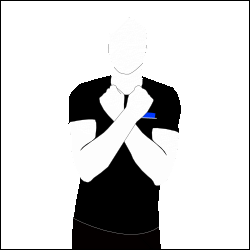
Sign to indicate to players that the catch was valid.
No Catch
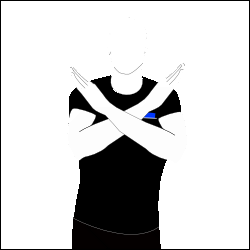
Sign to indicate to players that the catch was not valid.
Stop Play
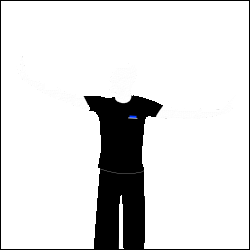
Sign to indicate to stop playing, after the whistle
Bounce
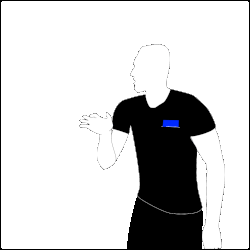
Sign to indicate to players that the ball bounced before the hit.
Block

Sign to indicate that the balls were blocked.
Play 'n' balls
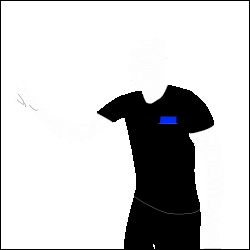
Play ball call indicating the number of balls that must be thrown.
Stay
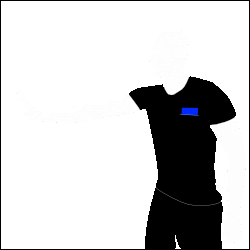
Sign to indicate to a player to stay.
Assemble
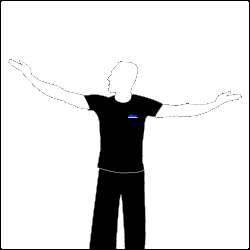
Sign to indicate to all referees to convene in the center
Turnover
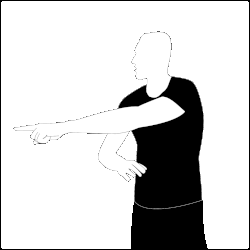
Sign to indicate a turnover of the balls. The officials points at the team who has to surrender all dodgeballs
Continue to play
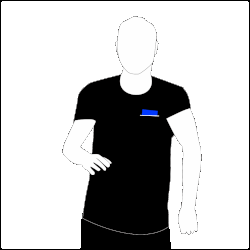
Sign to indicate to players to continue playing.
No / Safe / Not out
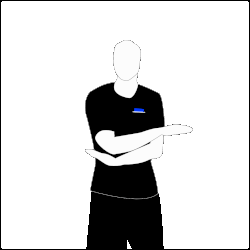
Sign to indicate that the player was not eliminated.

